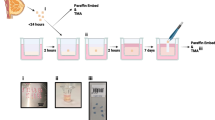Abstract
The expression of the aberrant N-acetylgalactosamine (GalNAc) glycoconjugates, detected by binding of the lectin from Helix pomatia (HPA) is reported to be associated with metastatic competence and poor prognosis in a range of human adenocarcinomas, but the functional significance of the glycoconjugates in metastatic mechanisms is unknown. We have employed seven cell lines derived from normal breast epithelium, primary breast cancer and breast cancer metastases which stably express varying levels of HPA-binding glycoconjugates consistent with their derivation and phenotype. These cell lines have been thoroughly characterised and express identical profiles of HPA-binding glycoconjugates as tumour cells derived from clinical samples. Their ability to adhere to, and invade through, basement membrane components was investigated in a matrigel assay system, and the functional role of the aberrant GalNAc glycans assessed by competitive inhibition experiments using HPA. The behaviour of the cell lines in these assay systems was entirely consistent with their derivation and phenotype, but there was no evidence that the glycoconjugates of interest were functionally involved in adhesion or invasion mechanisms. Research in our laboratory is ongoing to seek a functional role for the HPA-binding glycoconjugates in other aspects of the metastatic cascade.
Similar content being viewed by others
References
Brooks SA. Invited review: The involvement of Helix pomatia lectin (HPA) binding N-acetylgalactosamine glycans in cancer progression. Histol Histopathol 2000; 15: 143–58.
Brooks SA, Leathem AJC, Camplejohn RS et al. Markers of prognosis in breast cancer — the relationship between HPA binding and histological grade, SPF and ploidy. Breast Cancer Res Treat 1993; 25: 247–56.
Baker DA, Sugii S, Kabat EA et al. Immunochemical studies on the combining sites of Forssman hapten reactive haemagglutinins from Dolichos biflorus, Helix pomatia and Wisteria floribunda. Biochemistry 1983; 22: 2741–50.
Rye PD, Fodstad O, Emilsen E et al. Invasion potential and N-acetylgalactosamine expression in a human melanoma model. Int J Cancer 1998; 75: 609–14.
Terranova VP, Liotta LA, Russo RG et al. Role of laminin in the attachment and metastasis of murine tumour cells. Cancer Res 1982; 42: 2265–9.
Turpeenniemi-Hujianen T, Thorgeirrson UP, Rao CN et al. Laminin increases the release of type IV collagenase from malignant cells. J Biol Chem 1986; 261: 1883–9.
Briand P, Petersen OW, Van Deurs B. A new diploid nontumorogenic human breast epithelial cell line isolated and propagated in chemically defined medium. In Vitro Cell Dev Biol 1987; 23(1): 181–8.
Lasfargues EY, Coutinho WG, Redfield ES. Isolation of two human tumour epithelial cell lines from solid breast carcinomas. JNCI 1978; 61: 967–78.
Cailleau R, Young R, Olive M et al. Breast tumour cell lines from pleural effusions. JNCI 1974; 53: 661–73.
Filmus J, Pollak MN, Cailleau R et al. MDA-468, a human breast cancer cell line with a high number of epidermal growth factor receptors, has an amplified EGF receptor gene and is growth inhibited by EGF. Biochem Biophys Res Comm 1985; 128: 898–905.
Engel LW, Young NA, Tralka TS et al. Establishment and characterisation of three new continuous cell lines derived from human breast carcinomas. Cancer Res 1978; 38: 3352–64.
Soule HD, Vasquez J, Long A et al. A human breast cancer cell line from a pleural effusion derived from a breast carcinoma. JNCI 1973; 51: 1409–16.
Langlois AJ, Holder WD, Inglehart JD et al. Morphological and biochemical properties of a new human breast cancer cell line. Cancer Res 1979; 29: 2604–2613.
Brooks SA, Hall DMS, Buley I. GalNAc glycoprotein expression by breast cell lines, primary breast cancer and normal breast epithelial membrane. Br J Cancer 2001; 85(7): 1014–22.
Liotta L, Lee CW, Morakis DJ. A new method for preparing large quantities of intact human basement membrane for tumour invasion studies. Cancer Lett 1980; 11: 141–52.
Hart IR, Fidler IJ. An in vitro quantitative assay for tumour cell invasion. Cancer Res 1978; 38: 3218–24.
Armstrong PB, Quigley JP, Sidebottom E. Trans-epithelial invasion and intramesenchymal infiltration of the chick-embryo chorioallantois by tumour cell lines. Cancer Res 1982; 42(5): 1826–37.
Starkey JR, Hosick HL, Stanford DR et al. Interaction of metastatic tumour cells with bovine lens capsule basement membrane. Cancer Res 1984; 44(4): 1585–94.
Poste G, Fidler IJ. The pathogenesis of cancer metastasis. Nature (London) 1980; 283: 139–46.
Mareel MM, Dragonetti C. In vitro invasiveness of human bladder cancer from cell lines and biopsy specimens. Chem Exp Metastasis 1983; 1(2): 153–62.
Kleinman HK, McGarvey ML, Liotta LA et al. Isolation and characterisation of type IV procollagen, laminin and heparan sulfate proteoglycan from the EHS sarcoma. Biochemistry 1982; 21(24): 6188–93.
Ginestra A, La Placa MD, Saladino F et al. The amount and proteolytic content of vesicles shed by human cancer cell lines correlates with their in vitro invasiveness. Anticancer Res 1998; 18: 3433–8.
Author information
Authors and Affiliations
Corresponding author
Rights and permissions
About this article
Cite this article
Brooks, S.A., Hall, D.M. Investigations into the potential role of aberrant N-acetylgalactosamine glycans in tumour cell interactions with basement membrane components. Clin Exp Metastasis 19, 487–494 (2002). https://doi.org/10.1023/A:1020399516305
Issue Date:
DOI: https://doi.org/10.1023/A:1020399516305




